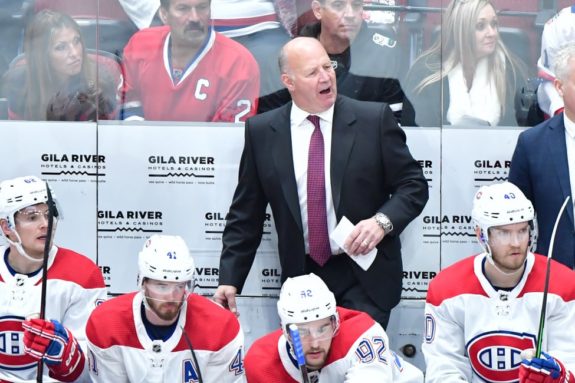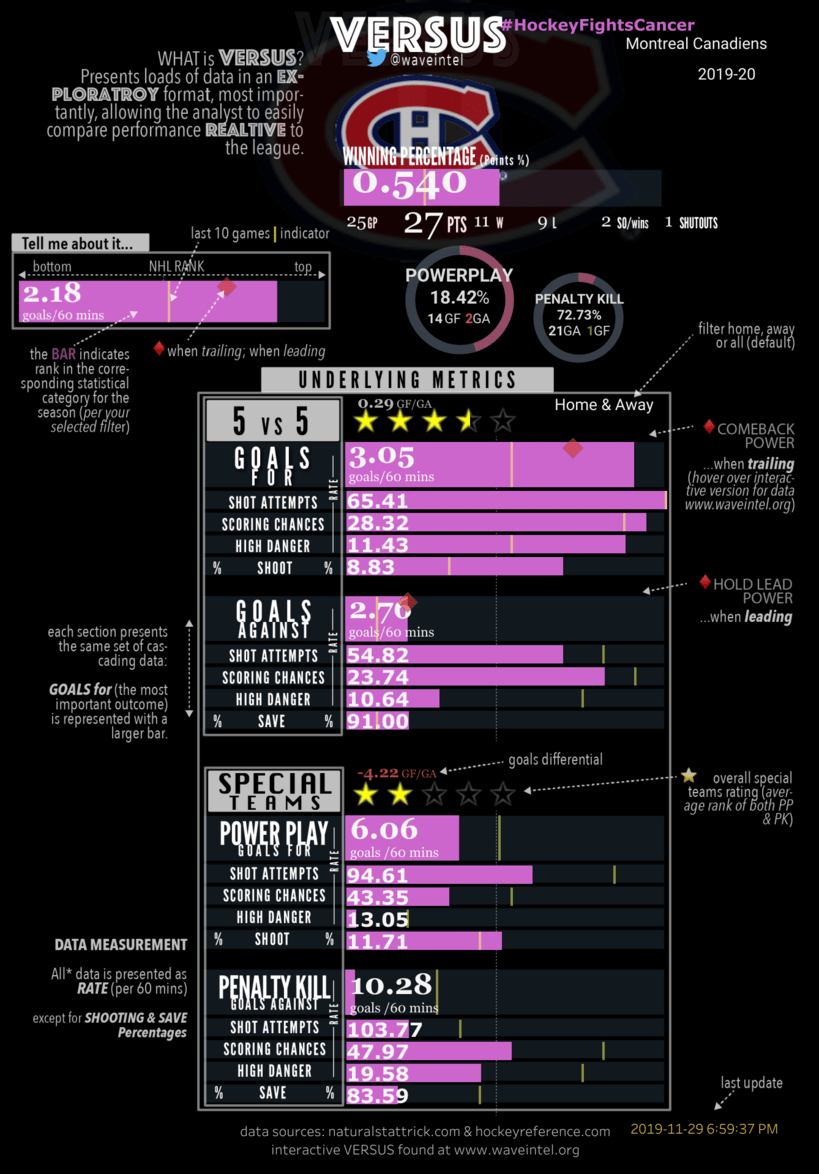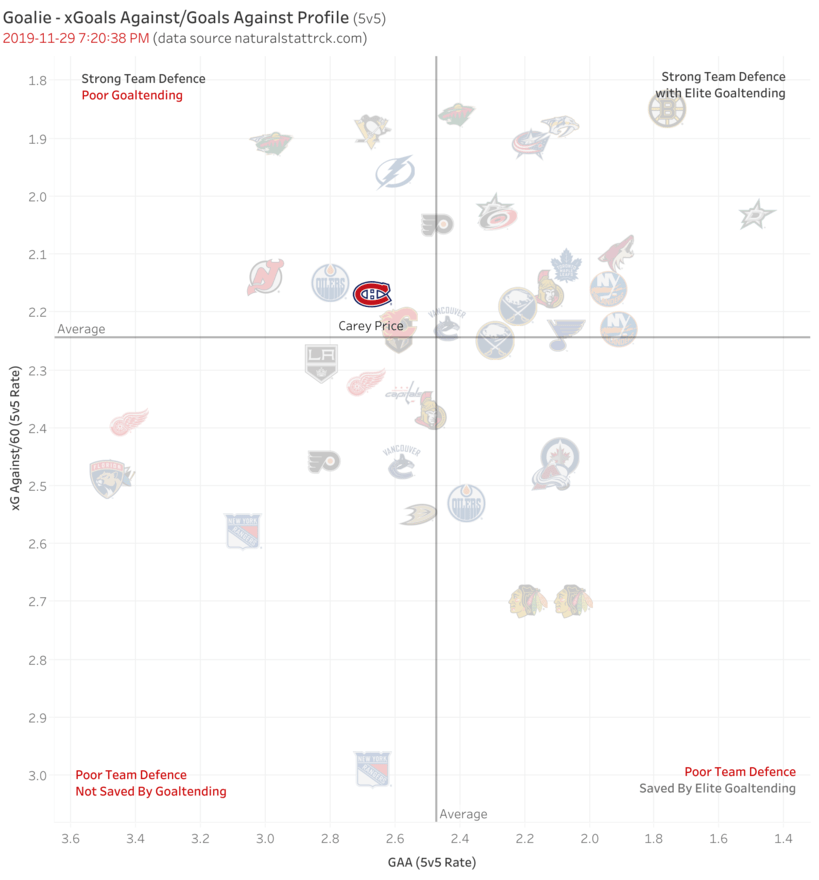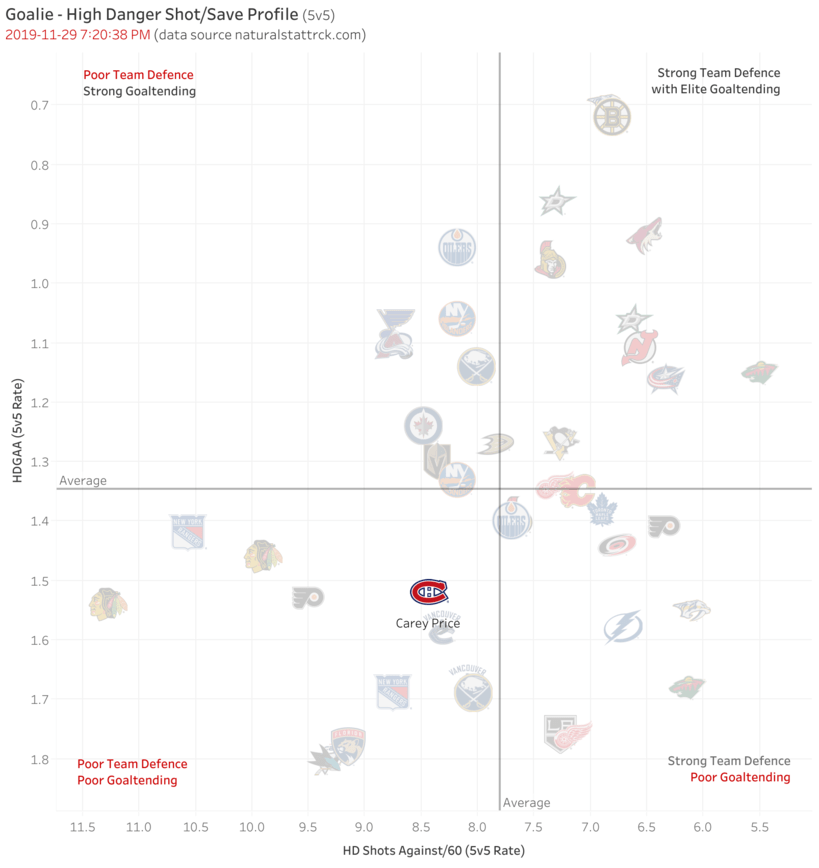I promised myself I would not write bad stuff about the Montreal Canadiens. Mired in a terrible stretch of hockey with only three wins in their last 10 games, it’s easy to join the mob of angry fans. But I want to abstain for now. So, I deleted the piece I started about general manager Marc Bergevin’s failings, and filed away the one about how awful the Canadian NHL teams have been relative to their American counterparts for more than two decades. I decided to let the numbers guide my investigation into what’s going wrong with the Canadiens.

First I will take a look at the general performance of the Canadiens to determine where to dig deeper. For this, I will use the VERSUS Tool to compare the Canadiens’ performance relative to the rest of the NHL.
Five-on-Five Play Deterioration
It’s easy to see in the graphic below that the Canadiens special teams performance is still poor, however during the last 10 games (denoted by the yellow lines), some of the important underlying numbers on the penalty kill are improving, notably the scoring chance suppression rates have moved into the top third of the NHL.
But what’s most concerning is the deterioration of the team’s five-on-five play, which has been the backbone of its success the past two seasons.
Without difficulty, you can see the season’s total (illustrated by the purple bars) for the five-on-five goals against performance is down well below the league average. So, the statistics are matching the eye test; the Canadiens are struggling to keep the puck out of the net.
Whats more concerning is the steep slide in performance the Canadiens are experiencing during five-on-five play. In the last 10 games, the team ranks 29th in five-on-five goals against per 60 mins. By contrast, in the first 10 games of the season, the Canadiens ranked 12th overall in that statistic. Without a doubt, the five-on-five defensive struggles are where our investigation should concentrate.
Problems with Five-on-Five Defence
So what’s wrong with the five-on-five defence? A quick look at the last 10 games indicators on the VERSUS report above shows that the underlying suppression numbers are actually quite good; better than the season’s average relative to the league. The Canadiens rank in the top third of the league at suppressing shot attempts, scoring chances and high danger chances.
The statistic that stands out is the five-on-five save percentage. In the last 10 games, the team’s save percentage is near the bottom of the NHL at 88.98%.

If we compare the Canadiens’ first 10 games of the season with the last 10 games, we can get a good idea of where the main issues are in the team’s five-on-five defence play. The rate of high danger chances against is virtually unchanged meaning the team is doing a good job of suppressing those chances. But the rate of high danger goals against has more than doubled from 1.02 per 60 mins to 2.43. The high danger save percentage has plummeted to 71.43% in the last 10 games.
Blame Carey Price
Based on these numbers alone, I think it is easy to point the finger at Carey Price. But hockey is a wildly unpredictable and highly variable sport. We need to dig deeper. Let’s look at how Price is performing relative to his peers.
Expected goals against is a good indicator of how a team is performing defensively, because it takes into consideration many factors including where the pass is coming from, shot distance, whether it is a rebound, and angle. The graphic above (minimum of 10 games played) shows that the Canadiens are an above-average team defensively, but Price is currently providing below-average performance. In other words, Price’s goals-against average is higher than what is expected based on the team’s play in front of him.
As we’ve seen in recent games, there seems to be a lot of odd-man rushes and open seams being exploited by the Canadien’s opponents. But as shown in the statistics, overall the Canadiens do a good job of suppressing those chances. It’s the team’s inability to stop those chances from going in that is the core problem.
The graphic above shows goalies (minimum of 10 games played) performance in stopping high danger shots. You can see, that when Price is in the net, the Canadiens allow high dangers shots at a higher rate than the league average. What’s worse, is that Price is not helping the team as several other goalies are doing under the same conditions as seen in the Poor Team Defence / Strong Goaltending quadrant in the graphic.
The Key to Success Is Found in the Slot
Based on these numbers, it is essential that the Canadiens get better goaltending from Price. But the blame cannot fully land on Price alone. The numbers can only take you so far; the coaches are, without doubt, examining what’s happening in the slot area – the high danger zone. Clearly the high danger rates against are too high when Price is in the nets, and those chances need to be examined more closely to understand their relative degree of danger. In other words, the Canadiens have to breakdown each of those high danger chances to understand how to better stop them. Are they allowing too many seam passes across the slot? Are chances generated from behind the goal line giving the team more problems than they should?
Unlike a month ago, when the penalty kill was the only glaring issue, the Canadiens coaching staff has a lot of work to do. At the top of the priority list is to work with Price and the defensive system to fix the issue in the high danger zone.


